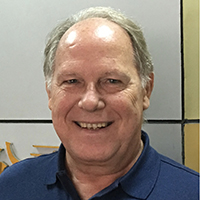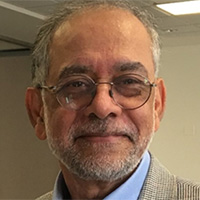Allan Kraus Award

John R. Thome
Professor-Emeritus, Ecole Polytechnique Fédérale de Lausanne (EPFL), Switzerland
Technical Director, JJ Cooling Innovation, Lausanne, Switzerland
Title: What are Pulsating Heat Pipes and are PHPs Ready for Cooling of Electronics?
Abstract: Pulsating heat pipes were first described in the literature about 30 years ago and in recent years have seen a huge interest by the research community. A pulsating heat pipe (PHP) is a long single channel formed into a serpentine path with its evaporator at its hot end (to cool electronics) and its condenser end cooled by air or water. In effect, the two-phase flow created by nucleation, bubble growth and the back-and-forth movement of the liquid slugs and elongated bubbles creates a “pulsating” motion. As such, a PHP operates without any wick, and fluid movement is only due to the pulsations self-created by the flow itself, which stems from the bubble nucleation process and bidirectional growth of confined bubbles in the small channels. Studies show that significant flow rates can be obtained, giving rise to good thermal performance up to potentially moderately high heat fluxes. Working fluids tested in laboratories are usually water, ethanol, dielectric fluids and refrigerants. A PHP can work vertically, inclined, horizontally and in some cases even against gravity. The physical phenomena is quite complex because of the unsteady reversing flow. In the talk today, I will describe some PHP configurations, their experimental thermal performance studies and some flow visualizations of the pulsating flow, then discuss the leading heat transfer mechanisms, and finally describe our 1-dimension PHP transient thermal/hydraulic simulation code (including simulation videos of the pulsating flow) to try to give a “flavor” of how PHPs actually work. The objective today is to stimulate discussion about the pros-and-cons of industrial application of PHPs.
Biography: John R. Thome is Professor-Emeritus of Heat and Mass Transfer at the Ecole Polytechnique Fédérale de Lausanne (EPFL), Switzerland, having set up and run the LTCM lab from 1998 to 2018 with more than a dozen of his PhDs and post-docs going on to professorships themselves. He is currently Technical Director of JJ Cooling Innovation in Lausanne, a two-phase electronics cooling consulting/software firm he co-founded in 2014, now with 4 employees. He obtained his PhD at Oxford University in 1978. He is also an Honorary Professor at the University of Edinburgh and a Visiting Professor at Brunel University in London…keeping his “feet wet” in research while still supervising MS student theses at the EPFL. He has authored five books on two-phase flow/heat transfer and has over 245 journal papers on macroscale and microscale two-phase flow, developed numerous new flow visualization techniques, extensively studied boiling and condensation heat transfer in microchannels and macrochannels, created the first flow pattern-based models, micro-two-phase cooling systems for electronics cooling together with thermosyphon simulation codes, developed 3D-inverse heat transfer methods for reducing multi-microchannel evaporator data, developed a transient 1-d numerical simulation tool for simulating the thermal performance of pulsating heat pipes, published 3D numerical work on bubbly and slug flows in microchannels with inhouse, OpenFoam and modified commercial codes, etc. He has done numerous sponsored projects with IBM, ABB, Nokia Bell Labs, Carl Zeiss, CERN, European Space Agency, etc. He received the 2017 Nusselt-Reynolds Prize, the IEEE Richard Chu ITHERM Award in 2019, the ASME Heat Transfer Division's Journal of Heat Transfer Best Paper Award in 1998, the United Kingdom’s Institute of Refrigeration J.E. Hall Gold Medal in 2008, the 2010 ASME Heat Transfer Memorial Award, the ICEPT-HDP 2012 Best Paper Award on a 3D-IC prototype with interlayer cooling (13,000 TVS's and 260 microchannels inside), the ASME Journal of Electronics Packaging Best Paper Award in 2014, and the Outstanding Paper Award at InterPACK2017. He is editor-in-chief of the 16-volume Encyclopedia of Two-Phase Heat Transfer and Flow (2016-2018). He founded the Virtual International Research Institute of Two-Phase Flow and Heat Transfer in 2014, now with 30+ participating universities to promote research collaboration, share experimental and numerical data, and organize PhD summer school courses. According to Google Scholar, he has an H-factor of 70 with over 23,300 citations.
InterPACK Achievement Award

Abhijit Dasgupta
Jeong H. Kim Professor
Center for Advanced Life Cycle Engineering (CALCE)
Mechanical Engineering Department
University of Maryland, College Park
Title: Developing Reliable Microsystems in the Era of Heterogeneous Integration
Abstract: Heterogeneous integration (HI) was conceived as a work-around for the semiconductor industry to get beyond the end of the economic and technological scalability of Moore’ Law. However, the resulting developments in system-in-package (SiP) multi-scale architectures have also unleashed a powerful collateral multi-physics revolution in the microsystems industry. System developers see HI as the next-generation platform for integrating many diverse functionalities, such as logic, memory, power, photonics, MEMS, energy storage, sensing and actuation, all into a single package. HI offers the potential to catalyze this convergence of technology and demand and to create a powerful inflexion in multi-functional technologies that will enable the world of intelligent, autonomous systems and Internet of Things (IoT).
Successful development of complex and reliable HI systems requires transformative changes in the ecosystem, to enable truly concurrent integration of heterogeneous development functions, such as design, manufacture, testing, qualification, and life-cycle management. The newly compiled pan-industry Heterogeneous Integration Roadmap (HIR) identifies Reliability as one of the cornerstones of this new domain and cautions that methods and tools for assuring higher performance will have to dovetail concurrently with those for assuring reliability, manufacturability, testability, sustainability, availability, affordability and resilience. Assurance of these attributes can no longer be sequential tasks if we have to bring such complex products to the marketplace in a timely manner. Methods and algorithms lack sufficient sophistication and will have to be based partly on the underlying fundamental multi-physics principles, and partly on machine-learning methods that exploit the massive availability of big-data.
This presentation will begin with a discussion of the current state of the art in multiscale, multiphysics approaches and big-data approaches, for developing highly reliable microsystems. Technology gaps, for timely development of complex next-generation HI systems, will be identified and critical shortfalls in current approaches will be discussed. Finally, potential roadmaps for new break-through approaches will be presented.
Biography: Abhijit Dasgupta is Jeong H. Kim Professor of Mechanical Engineering at the University of Maryland (UMD), with research experience in the microscale and nanoscale mechanics and reliability physics of engineered materials used in conventional and additively manufactured 3D flexible electronic packaging and intelligent microsystems. He holds a Ph.D. in Theoretical and Applied Mechanics from the University of Illinois at Urbana-Champaign (UIUC), and has been a principal investigator at the Center for Advanced Life Cycle Engineering (CALCE) at UMD for the past 30 years, conducting research in reliability physics, design for reliability, accelerated stress testing, and real-time health management. He has published over 300 articles and conference papers; served on editorial boards of two international archival journals; presented over 40 workshops and short courses; helped form research and educational roadmaps for the electronics industry, and provided consulting services to numerous industry leaders. He has presented multiple keynote talks at international conferences, received 6 best-paper awards and received 8 major awards in recognition of his research and educational contributions. He is an ASME Fellow, past Chair of the ASME Electronic and Photonic Packaging Division (EPPD), current member of the ASME Design, Manufacturing and Materials Segment Leadership Team (DMM-SLT) and Reliability Topic Lead in the multi-society Heterogeneous Integration Roadmap (HIR) Team.